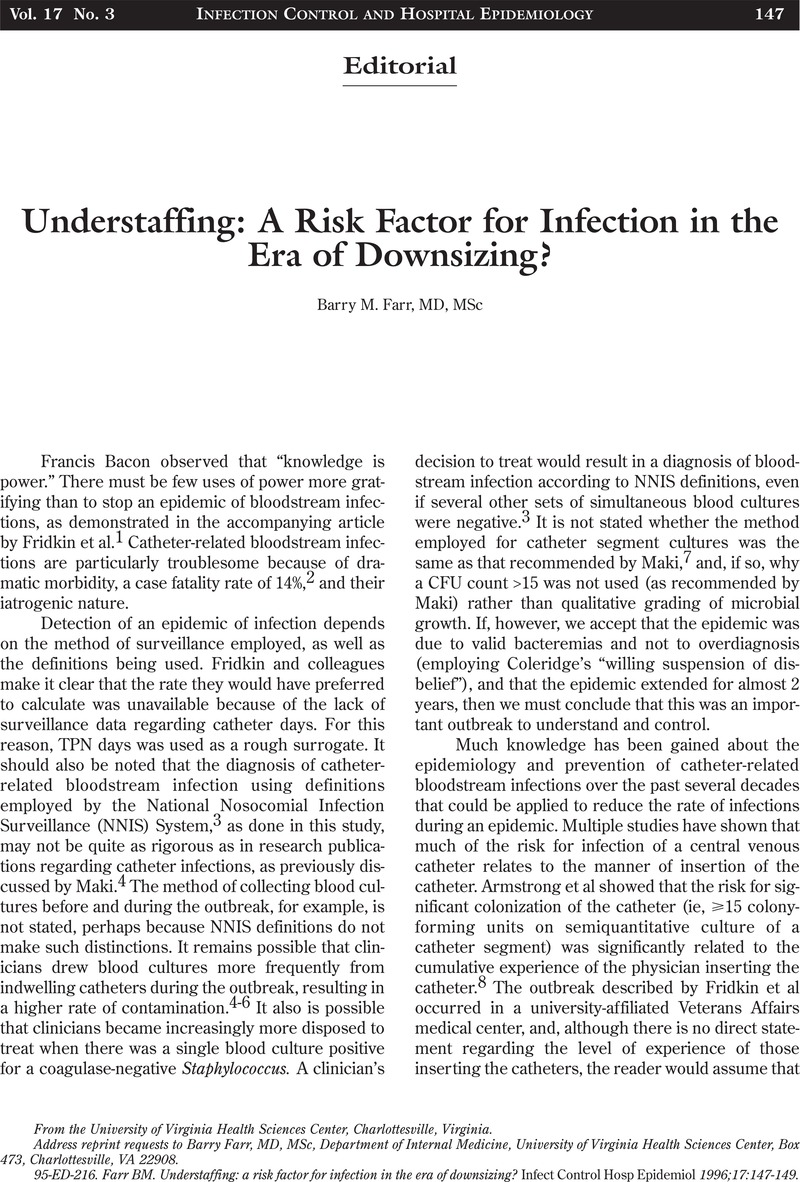No CrossRef data available.
Article contents
Understaffing: A Risk Factor for Infection in the Era of Downsizing?
Published online by Cambridge University Press: 02 January 2015
Abstract
An abstract is not available for this content so a preview has been provided. As you have access to this content, a full PDF is available via the ‘Save PDF’ action button.

- Type
- Editorial
- Information
- Copyright
- Copyright © The Society for Healthcare Epidemiology of America 1996
References
1.Fridkin, SK, Pear, SM, Williamson, TH, Galgiani, JN, Jarvis, WR. The role of understaffing in central venous catheter-associated bloodstream infections. Infect Control Hosp Epidemiol 1996;17:150–157.Google Scholar
2.Byers, KE, Adal, KA, Anglim, AM, Farr, BM. Case fatality rate for catheter-related bloodstream infections (CRBSI): a metaanalysis. Infect Control Hosp Epidemiol 1995;16:P23. Abstract 43.Google Scholar
3.Garner, JS, Jarvis, WR, Emori, TG, Horan, TC, Hughes, JM. CDC definitions for nosocomial infections, 1988. Am J Infect Control 1988;16:128–140.Google Scholar
4.Maki, DG. Infections due to infusion therapy. In: Bennet, JV, Brachman, PS, ed. Hospital Infections. 2nd ed. Boston, MA: Little, Brown and Co; 1992:849–899.Google Scholar
5.Bates, DW, Goldman, K, Lee, TH. Contaminant blood cultures and resource utilization. JAMA 1991;265:365.Google Scholar
6.Bryant, JK, Stand, CL. Reliability of blood cultures collected from intravascular catheter versus venipuncture. Am J Clin Pathol 1987;88:113–116.Google Scholar
7.Maki, DG, Weise, CE, Sarafin, HW. A semiquantitative culture method for identifying intravenous-catheter-related infection. N Engl J Med 1977;296:1305–1309.Google Scholar
8.Armstrong, CW, Mayhall, CG, Miller, KB, et al. Prospective study of catheter replacement and other risk factors of infection of hyperalimentation catheters. J Infect Dis 1986;154:808–816.Google Scholar
9.Mermel, LA, McCormick, RD, Springman, SR, Maki, DG. The pathogenesis and epidemiology of catheter-related infection with pulmonary artery Swan-Ganz catheters: a prospective study utilizing molecular subtyping. Am J Med 1991;91(suppl 3B):1975–2055.Google Scholar
10.Raad, II, Hohn, DC, Gilbreath, BJ, et al. Prevention of central venous catheter-related infections by using maximal sterile barrier precautions during insertion. Infect Control Hosp Epidemiol 1994;15:231–238.Google Scholar
11.Snydman, DR, Murray, SA, Kornfeld, SJ, Majka, JA, Ellis, CA. Total parenteral nutrition related infections: prospective epidemiologic study using semiquantitative methods. Am J Med 1982;73:695–699.Google Scholar
12.Klein, BS, Perloff, WH, Maki, DG. Reduction of nosocomial infection during pediatric intensive care by protective isolation. N Engl J Med 1989;320:1714–1721.Google Scholar
13.Faubion, WC, Wesley, JR, Khalidi, N, Silva, J. Total parenteral nutrition catheter sepsis: impact of the team approach. JPEN 1986;10:642–645.Google Scholar
14.Freeman, JB, Lemire, A, Maclean, LD. Intravenous alimentation and septicemia. Surg Gynecol Obstet 1972;135:708–712.Google Scholar
15.Nehme, AE. Nutritional support of the hospitalized patient. The team concept. JAMA 1980;243:1906–1908.Google Scholar
16.Nelson, DB, Kien, CL, Mohr, B, Frank, S, Davis, SD. Dressing changes by specialized personnel reduce infection rates in patients receiving central venous parenteral nutrition. JPEN 1986;10:220–222.Google Scholar
17.Cobb, DK, High, KP, Sawyer, RG, et al. A controlled trial of scheduled replacement of central venous and pulmonaryartery catheters. N Engl J Med 1992;327:1062–1068.Google Scholar
18.Howell, PB, Walters, PE, Donowitz, GR, Farr, BM. Risk factors for infection of adult patients with cancer who have tunneled central venous catheters. Cancer 1995;75:1367–1375.Google Scholar
19.Maki, DG, Stolz, S. The epidemiology of central-venous catheterrelated bloodstream infection (BSI). Programs and Abstracts of the 34th Interscience Conference of Antimicrobial Agents and Chemotherapy; Orlando, FL; 1994. Abstract J47.Google Scholar
20.Baxter, JK, Babineau, TJ, Apovian, CM, et al. Perioperative glucose control predicts increased nosocomial infection in diabetics. Crit Care Med 1990;18(4):207.Google Scholar
21.Babineau, TJ. TPN vs TEN decision analysis. In: Malnutrition in the Hospitalized Patient. Boston, MA: Harvard Medical School; 1995.Google Scholar
22.Danzig, L, Short, L, Collins, K, et al. Bloodstream infections (BSIs) associated with a needleless intravenous (IV) infusion system used in patients on home infusion therapy. Programs and Abstracts of the 34th Interscience Conference of Antimicrobial Agents and Chemotherapy; Orlando, FL; 1994. Abstract J200.Google Scholar
23.Levin, A, Mason, AJ, Jindal, KK, Fong, IW, Goldstein, MB. Prevention of hemodialysis subclavian vein catheter infections by topical povidone iodine. Kidney Int 1991;40:934–938.Google Scholar
24.Conly, JM, Grieves, K, Peters, B. A prospective, randomized study comparing transparent and dry gauze dressings for central venous catheters. J Infect Dis 1989;159:310–319.Google Scholar
25.Maki, DG, Stolz, SM, Wheeler, SJ, Mermel, LA. A prospective, randomized trial of gauze and two polyurethane dressings for site care of pulmonary artery catheters: implications for catheter management. Crit Care Med 1994;22:1729–1737.Google Scholar
26.Prager, RL, Silva, J. Colonization of central venous catheters. South Med J 1984;77:458–461.Google Scholar
27.Maki, DG, Ringer, M, Alvarado, CJ. Prospective randomized trial of povidone-iodine, alcohol, and chlorhexidine for prevention of infection associated with central venous and arterial catheters. Lancet 1991;338:339–343.Google Scholar
28.Mimoz, O, Pieroni, L, Lawrence, C, Edouard, A, Samii, K. Prospective trial of povidone-iodine (PI) and chlorhexidine (CH) for prevention of catheter-related sepsis (CRS). Programs and Abstracts of the 34th Interscience Conference of Antimicrobial Agents and Chemotherapy; Orlando, FL; 1994. Abstract J56.Google Scholar
29.Sheehan, G, Leicht, K, O'Brien, M, Taylor, G, Rennie, R. Chlorhexidine versus povidone-iodine as cutaneous antisepsis for prevention of vascular-catheter infection. Programs and Abstracts of the 33rd Interscience Conference of Antimicrobial Agents and Chemotherapy; New Orleans, LA; 1993. Abstract 1616.Google Scholar
30.Flowers, RH, Schwenzer, KJ, Kopel, RF, Fisch, MJ, Tucker, SI, Farr, BM. Efficacy of an attachable subcutaneous cuff for the prevention of intravascular catheter-related infection: a randomized, controlled trial. JAMA 1989;216:878–883.Google Scholar
31.Maki, DG, Wheeler, SJ, Stolz, SM, Mermel, LA. Clinical trial of a novel antiseptic central venous catheter. Programs and Abstracts of the 31st Interscience Conference of Antimicrobial Agents and Chemotherapy. Chicago, IL; 1991. Abstract #461.Google Scholar
32.Haley, RW, Bregman, DA. The role of understaffing and over-crowding in recurrent outbreaks of staphylococcal infections in a neonatal special-care unit. J Infect Dis 1982;145:875–885.Google Scholar
33.Fauerbach, LL, Schoppman, MJ, Singh, VR, Netardus, LS, Pickett, DL, Shands, JW. A comparison of the efficacy of different antiseptics for intravascular site preparation. Programs and Abstracts of the 31st Interscience Conference of Antimicrobial Agents and Chemotherapy; Chicago, IL: 1991. Abstract 1269.Google Scholar




